Kick-Starting An Old Motorcycle
Article by Mark Trotta
Up until the early 1970s, most motorcycles were kick-start only, but as more people began riding, electric-start became increasingly requested by newer riders. Eventually, an electric starter became standard equipment on most street machines.

One of the challenges of classic and vintage motorcycle ownership is learning to start them with as few kicks as possible. And that's good for you, and for the bike!
Although the basic techniques for kick-starting an old motorcycle are the same, every bike is a little different--even two of the same make and model can be slightly different.
*******************
For an engine to start, it must have compression, spark, and fuel. Engine timing (when the valves open and close in relation to piston travel) needs to be correct, and of course, nothing damaged or broken in the motor.
Know Where The Compression Stroke Is
The four phases of a four-stroke gas engine are intake, compression, power, and exhaust. Top Dead Center is when the intake and exhaust valves are closed, and the #1 piston is coming up to compress the air/fuel mixture.
To start a kick-start bike as easily as possible, learn where Top Dead Center (TDC) is on the kick-pedal. This is the compression stroke. Before turning on the ignition switch or opening the fuel valve, slowly kick on the kick-lever, and when you feel resistance, you're on the compression stroke.
With a little experience, you'll be able to feel the compression stroke quickly, it's at the top of the kicking arc. Simply put, if you're not on the compression stroke, the bike's not gonna start.
Cold-Start Kicking
Before turning on the fuel and ignition switch, kick the bike over two or three times. This is to get the engine primed with oil. Then turn on the fuel valve, and the choke (or enrichener device), and finally, the ignition switch. Twist the throttle once or twice, find the compression stroke and kick. A motor in good tune should start in several kicks.
Warm-Start Kicking
Motorcycles start easier once they're warmed up. Starting procedure would be fuel on, one or two twists on the throttle, ignition on and kick. No choke or enrichener should be needed. A well-tuned motor should start in a kick or two.
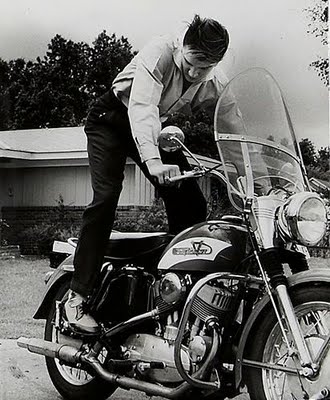
Elvis Presley kick-starting his Harley K Model
Standing Over Or Next To The Bike
A common position to kick start a motorcycle is standing next to it, but they can also be started while being straddled. To do this, put the bike on the kickstand, balance yourself with your left foot on the left foot-peg, and kick with your right foot. This kicking angle usually requires less effort.
For high-compression, big-displacement engines, you'll need to get more power into the kick. Try standing to the right of the bike using your left foot to kick. If you don't weigh much, it gives you better leverage to kick down with. When I was a teenager, this was the technique that helped me kick-start bikes that were bigger than I was!
You can also try resting your left knee up on the seat while kicking the bike over. This places all the weight from your left side "above the action", and if the engine were to kick back, you'd be more likely to be shoved upward instead of hyper-extending your right knee.
Keep The Bike In Tune
It's true - kick-only motorcycles are more finicky to start than an electric-start motorcycles. If your bike has ignition points, check the gap every few thousand miles. Take out the spark plugs, clean them and check the gap - perhaps try a wider gap.
Non-Stock Engines
If your motor is modified, it's very important to find a carburetor that works well on your bike. Back when I was riding my 1972 XLCH Sportster, other Harley riders used to mock my 40mm Mikuni carburetor because it was Japanese, but it worked well. To my delight and their surprise, the bike started consistently on the 1st or 2nd kick.
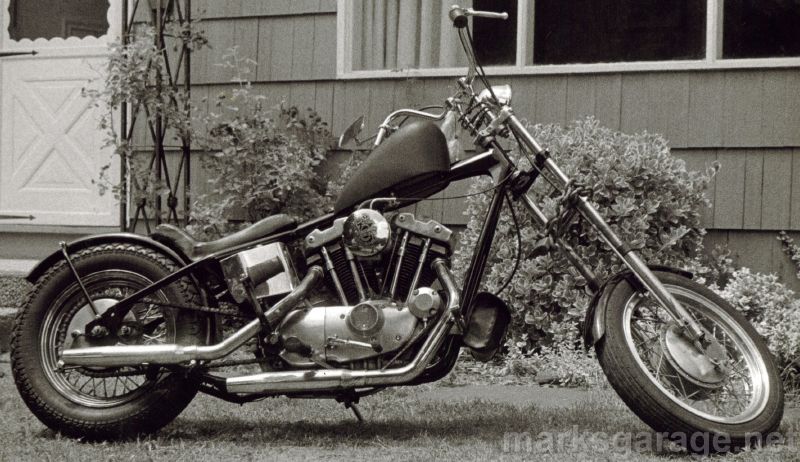
If the Bike Still Doesn't Start
If the engine "spits" out the exhaust pipes while you're kicking, you're getting closer. but you may have flooded the motor by twisting the throttle too much. If you think you did, try holding the throttle all the way open when you kick.
To make sure you're getting gas, remove a spark plug and see if it looks wet or smells like gas.
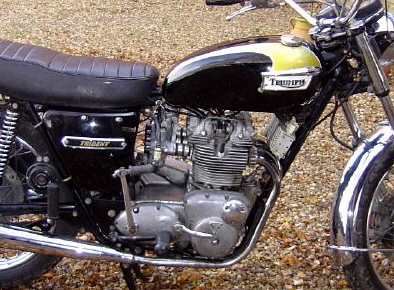
Check Your Battery
Since kickstart bikes don't rely on a battery for starting, it can be in pretty bad shape without you knowing. Check battery cable connections, and also the fluid level. Top off with water if necessary, and allow to stand awhile before charging. Recharge it with a small amperage trickle charger overnight.
*******************
Which Grade Oil?
Chances are you won't be riding your vintage bike for hours in hot weather, so a 60w or 50w grade of oil won't hurt the motor and will make the bike easier to kick. In winter months, you can run 20/50 oil to make starting easier
I have run 70w oil in my old Ironhead Sportster, but more recently I've run 50w in my kick-only 1974 Triumph Trident and 60w in my kick-only 1974 Norton Commando.
*******************
Starting a Motorcycle with Manual Advance
Many pre-1960's motorcycles did not have automatic timing advance. It was often controlled manually by a cable, usually from the left-hand grip to the distributor.
To start a bike with a manual advance, such as an old Linkert-equipped Harley, try the following. With ignition off, turn the gas on, full choke, and retard the timer (twist left-hand grip). Give two full kicks, one click off on choke, then turn on the ignition switch. One good kick may start it. If it does, advance the distributor. Open the choke as soon as it warms up.
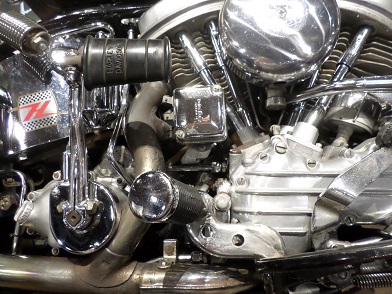
If it takes more than a dozen kicks to start your bike, look for another problem. Start at the spark plugs--if the plugs are wet, the motor is getting gas.
To check for spark, you can either take off your points cover and see if the points are sparking, or remove one spark plug and ground it to the frame or engine. Then kick the bike slowly with the ignition switch on while watching if the plug electrode is getting spark.
Conclusion
Kick-starting an old motorcycle is part of classic bike culture. Hopefully some of these tips and techniques will help newer riders with older machines. Once starting procedures are learned, they become second-nature to you. And wear a good pair of boots--you should be anyway.
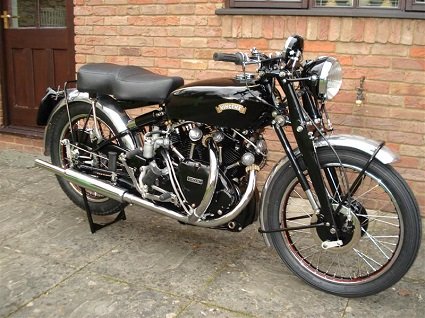
Fun Fact: Kick-start-only bikes are lighter and less complicated than electric-start bikes.
*******************
How To Fix A 'Migrating' Kick Lever
Sometimes with age, the upper part of the kick lever pedal, after being closed, will "wander" out and be in the way of the right foot.
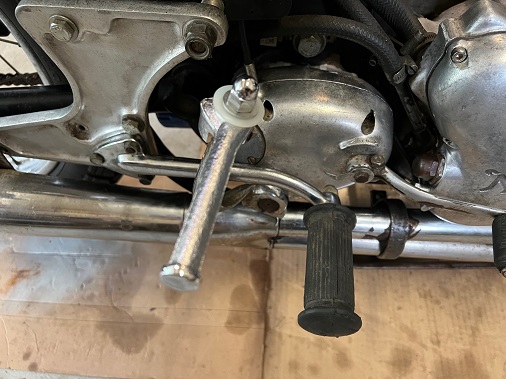
The simple hack here is to add either a nylon washer or thin 'spring' washer under the top nut.
*******************
Related Articles: